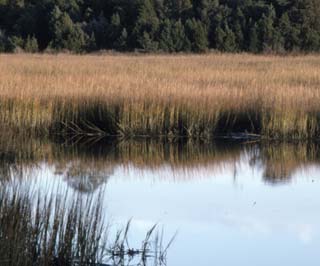Marine - Tidal Creeks
 Winding through the flat expanse of salt marsh, tidal creeks serve to distribute the energy generated by plant growth to the entire estuary. These small creeks, some almost dry at low tide, also provide critical nursery areas for many species of fish and invertebrates.
Winding through the flat expanse of salt marsh, tidal creeks serve to distribute the energy generated by plant growth to the entire estuary. These small creeks, some almost dry at low tide, also provide critical nursery areas for many species of fish and invertebrates.
Abundant food and protection from predators make salt marsh creeks ideal nursery grounds. As a result, larvae and juveniles dominate the marsh creek fauna, as much as 95 percent of the animals sampled in some studies.
With seasonally staggered live cycles, wave after wave of various species, including seatrout, crevalle jack, flounder, spadefish, spot, black drum, blue crab, brown shrimp and white shrimp, enter these creeks, mature and move to deeper water. When high tide floods the bed of the marsh, these animals have access to the nutrient-rich marsh mud while the dense growth of cord grass in many areas restricts entry by larger predators.
On the outgoing tide, however, predators such as seatrout and red drum lurk at the mouths of the creeks feeding on the smaller organisms flushed first from the marsh and then from the smaller creeks. Additionally, dispersal in shallow water at high tide makes these animals vulnerable to avian predators including wading birds and terns.
The many predators, both avian and aquatic, that make their living from estuarine waters attest to the richness of the salt marsh. The miles of tidal creeks make these nutrients available to hundreds of species, many of them of commercially and recreationally importance.
